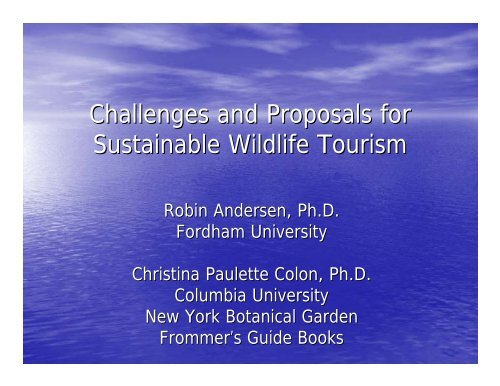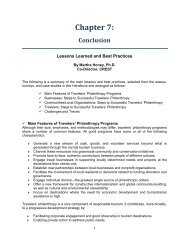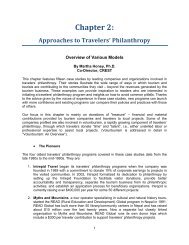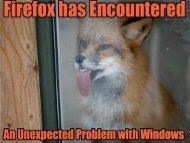Challenges and Proposals for Sustainable Wildlife Tourism- Robin ...
Challenges and Proposals for Sustainable Wildlife Tourism- Robin ...
Challenges and Proposals for Sustainable Wildlife Tourism- Robin ...
- No tags were found...
Create successful ePaper yourself
Turn your PDF publications into a flip-book with our unique Google optimized e-Paper software.
<strong>Challenges</strong> <strong>and</strong> <strong>Proposals</strong> <strong>for</strong><strong>Sustainable</strong> <strong>Wildlife</strong> <strong>Tourism</strong><strong>Robin</strong> Andersen, Ph.D.Fordham UniversityChristina Paulette Colon, Ph.D.Columbia UniversityNew York Botanical GardenFrommer’s s Guide Books
Patterns• Natural areas, habitat <strong>and</strong>species are rapidlydeclining worldwide• Humans are increasinglyliving in urbanized <strong>and</strong>non-natural natural settings• <strong>Tourism</strong> to wild places isincreasing• Animals are majorattractions <strong>for</strong> manydestinations<strong>Tourism</strong> to remote places includingTahiti <strong>and</strong> Baja Cali<strong>for</strong>nia isexp<strong>and</strong>ing
• Tourists are willing tobare the costs to see,pet, feed <strong>and</strong> otherwiseinteract with wildlifePractice• What is common <strong>for</strong>some is exotic <strong>for</strong> othersBaby king penguin in Antarctica withcrew from Lindblad Expeditions ship• Tour operators facilitatewildlife encounteropportunitiesTam<strong>and</strong>ua at Belize Zoo during night walk
• Most wildlife tourism isunregulated <strong>and</strong>unmonitoredProblems• Most tourists do not knowthe impact of theirwildlife encounters• Most tour operators arenot wildlife or habitatspecialists• Researchers <strong>and</strong> wildlifemanagers struggle tounderst<strong>and</strong> its impact.Family approaching pig tailedmacaque in BorneoHow cananimal/humanencounters inspireconservation action?
“Something ineffablehappened in those fewmoments, something sowonderful <strong>and</strong> profoundthat it awakened myconscience <strong>and</strong> <strong>for</strong>everchanged the way I feltabout animals.”David WesternQuickTime <strong>and</strong> adecompressorare needed to see this picture.“The vision of the sable antelope is the book’sleitmotif, serving at times of stress to remindWestern of his primal commitment to savingAfrica’s s wildlife.” John Terborgh
Proposed Paradigm• Based on more than ten years ofobservations <strong>and</strong> several years of researchworldwide, we’ve noticed several patternsof wildlife tourism• Each category is described below• Differences <strong>and</strong> similarities are discussed• Proposed actions <strong>for</strong> all categories aremade based on patterns observed
Existing Cultural ContextCultural <strong>and</strong> economic practices currently shapeanimal encounters• Set expectation• Position the visitor in relation to nature <strong>and</strong> wildlife• Influence <strong>and</strong> rein<strong>for</strong>ce certain attitudes over others• Invite behavior toward animals
Edutainment Modelrecreation, fun, entertainmentsome in<strong>for</strong>mation, often not accurate• Captive wild animalsper<strong>for</strong>ming tricks, orbehaviors by a trainer whorewards animal with treat orpraise• Few if any focus onconservation, habitatdestruction or other threats– Dolphin swims– Dolphin shows– Animal acts– Circus showsDolphin show at Curacao Seaquarium
Dolphins Plus Inc.Key Largo, Florida• Structured Dolphin Swim Program• Tame animals most now born in captivity
CubaEducationalopportunity, yet verylittle in<strong>for</strong>mationabout the animals,the environment ortheir habitat.No interpretivematerials availableHigh degree ofcommunicationblocks: languagebarriers
CubaAlmost no instructionabout behavioralrequirement <strong>for</strong> theinteractionThirteen to fifteen peopleinteract with twodolphins.Some not focused oninstruction from trainersor at times, the animals.
Dolphins Required toTow 2 People
Cuba• Location: Remote facility <strong>for</strong> marine mammals offersless negative impact on habitat pressures <strong>and</strong>animal populations in the wild.
Biodiversity impact occurs with the capture ofindividual animals from the wild
Adventure• Experiencesbecomethrilling
• Animalsbecomedangerous• Humansinvited to beaggressive
Extreme Action Model• Objective is danger<strong>and</strong> excitement• Adrenaline rush with noregard <strong>for</strong> the animals• No education or concern<strong>for</strong> wildlife habitatBanana boat speeds past sealion colony in Cabo• Low safety st<strong>and</strong>ard <strong>for</strong>visitors <strong>and</strong> animalsTube inside shark tank in Atlantisallows visitors to pass safely
Whale Watching• High cost <strong>and</strong> ef<strong>for</strong>t• Dependent onweather conditions• No guarantee ofsightings• Enjoyable boat ride• Alternate species toview such as sea lions<strong>and</strong> bird colonies• Dramatic scenery• Free second trip if nowhales seen
Snorkel <strong>and</strong> Dive Model• Many marine animals aresessile or slow moving• Seldom resemble animals<strong>and</strong> there<strong>for</strong>e subject toexcessive h<strong>and</strong>ling• Ocean is not as easilydefined as property• More susceptible toTragedy of the Commons
Dolphins Plus Inc.Key Largo, Florida• Dolphin-Child“Therapy”with “Isl<strong>and</strong> Dolphin Care”• “A A not-<strong>for</strong><strong>for</strong>-profit organization developed to help children<strong>and</strong> their families cope with various developmental,physical, <strong>and</strong>/or emotional disabilities. Their goal is toprovide a therapeutic, recreational environment thatfocuses on the emotional <strong>and</strong> physical well being of theparticipant <strong>and</strong> their family members.”
Healing/Therapy Model• Animals purported to havehealing powers• Encounter intended to treator cure diseaseAccording towww.dolphinhealing.net:“Dolphins are highly evolved omnidimensional beings who live in theOneness. Their role is similar to that ofthe angelic kingdom. Like the angels,the dolphins' influence transcendstime, space <strong>and</strong> physicality.”• Misin<strong>for</strong>mation about theanimals, their behavior <strong>and</strong>their capabilities presented• Implied claims that animalscan detect <strong>and</strong> heal tumors,cancers <strong>and</strong> injuries
Conservation Identity Models * shouldtrans<strong>for</strong>m existing cultural models in StrategicCommunication DesignThe style <strong>and</strong> content of promotional material designedto appeal to needs <strong>and</strong> expectations withcorresponding conservation messages.• Curiosity Driven; seeks to learn more• Experience Seeker; derives pleasure from visitingecologically notable ecosystems <strong>and</strong> charismaticwildlife• Spiritual Pilgrim; seeking contemplative or restorativeexperience• Naturalist/Altruist; enhance commitment, knowledge<strong>and</strong> outreachmodified from the AZA
Conservation Identity Models * shouldaddress existing cultural models in StrategicCommunication DesignThe content of promotional material appealing to expectationswith corresponding conservation messages.• Edutainment/Mystery• Curiosity Driven; seeks to learn more• Action/Adventure Trainer• Experience Seeker; derives pleasure fromvisiting ecologically notable ecosystems <strong>and</strong>charismatic wildlife• Healing/Therapy• Spiritual Pilgrim; seeking contemplative orrestorative experience• Naturalist/Altruist; enhance commitment*modified from the AZA
Private <strong>Wildlife</strong> Facilities• Natural breeding• <strong>Wildlife</strong> chooselocation• Humans encouragebreeding• Man made viewingarea• Multiple species• UnregulatedPenguin Place in New Zeal<strong>and</strong>
Animal Farm Model• Domesticated non-native species• Bred <strong>for</strong> profit byprivate owner• Sold <strong>for</strong> meat,feathers, eggs etc• Sold in gift shop <strong>and</strong>exportedCuracao Ostrich Farm
Safari Model• Animals large <strong>and</strong>/or easyto spot from a distanceeither out in open or upin trees• In protected naturalareas with open terrain• Habituated or slow• Multiple species to viewin natural habitat• Indirect evidence ofwildlife easy to spot <strong>and</strong>rewarding if no animalsare seenAustralian wildlife in parks <strong>and</strong> reserves
Sanctuary Model• Sanctuary <strong>for</strong> displaced orferal animals• Donkeys primates <strong>and</strong>other beasts of burdenimported to isl<strong>and</strong>s at turnof century• Tame but dangerous or anuisance to citizens• Often run by animal welfareagency or non-profit• Proceeds support sanctuary• Serves tourists <strong>and</strong> acommunity service
Voluntourism Model• Tourists pay <strong>for</strong> theprivilege of volunteeringon a wildlife conservationproject• Work with researchers<strong>and</strong> trained guides tomonitor, observe orprotect animals, habitat<strong>and</strong> eggs or nestlings• Highly educational• High profile• Well managed• Well fundedMacaw research inTambopata AmazonSea turtle egg removal <strong>for</strong>hatch <strong>and</strong> release
Conservation <strong>and</strong> Breeding Model• Breeding or rehabilitationfacility <strong>for</strong> endangered species• Ultimate goal is restoration ofpopulation through research,breeding <strong>and</strong> release• Run by non-profit group <strong>and</strong>volunteers
Community Development Model• <strong>Wildlife</strong> encounter inthe context ofconservation <strong>and</strong>communitydevelopment <strong>and</strong> localconservation ethic• Education aboutspecies <strong>and</strong> threats aswell as interactionwith locals <strong>and</strong>cultural connectionsCommunity Baboon Sanctuary in Belize
<strong>Wildlife</strong> Touristsas Stakeholder, ManagementParticipant, <strong>and</strong> In<strong>for</strong>mation SourceProviding Codes of Conduct• A checklist should be provided to guide<strong>and</strong> in<strong>for</strong>m the responsible wildlife tourist• This can be a first step towards moreresponsible behavior <strong>and</strong> philanthropy
• Wild animals have theright to be wild• By definition, they arecapable of <strong>and</strong> withintheir rights to defendthemselves from real<strong>and</strong> perceived danger• Perceived threats caninclude eye contact,petting, feeding,sudden movements,loud noises, <strong>and</strong>chasing, pursuing orcorrallingWILD IS WILD
• H<strong>and</strong>ling or touchingcauses stress, manifestas freezing (oftenmistaken <strong>for</strong> tameness)or unprovoked attack• Chasing or corneringmimics predation,inducing a flight orfright response• Long term effects leadto illness, death, or lossof anti-predatoryresponseDON’T T TOUCHCaptive born jaguar at Belize Zoo
FEEDING IS HARRASSMENT• Feeding can result inillness <strong>and</strong> death• Even appropriate foodchanges natural <strong>for</strong>agingbehavior <strong>and</strong> leads tohabituation• Animals that exhibitnatural <strong>for</strong>aging protectswildlife, their food-webs,tourists <strong>and</strong> local residentsWild iguana in ArubaImported monkey in Grenada
TAKE ONLY PICTURES• Do not purchase, consumeor collect parts of wildanimals or their resources• Even when legal,consumption oftenunmonitored• Lack of underst<strong>and</strong>ing canlead to population declineor local extinctionBlack coral jewelry in GrenadaMolded coral figurines in British Virgin Isl<strong>and</strong>s
Empowering Tour Operators• As gatekeepers they hold all power• Perception of who holds power is invertedin developing countries• Guides dictate <strong>and</strong> mediate the experience<strong>and</strong> expectation of tourist• Tourists want to be educated <strong>and</strong> open tonew in<strong>for</strong>mation <strong>and</strong> ideas
EVALUATING WILDLIFE TOUROPERATORS• Tour operators, guides <strong>and</strong>staff often lack knowledgeon ecology <strong>and</strong>conservation issues• Interpretation should beposted <strong>and</strong> stated• In<strong>for</strong>mation should includenatural history, range,diet, conservation status<strong>and</strong> threatsAtlantis has the largest aquarium inthe world, but not a single sign
SIZE MATTERS• Groups should be smallwhen interacting withsensitive species (20)• Visitors must be briefedon appropriate conduct• Briefing should specifyminimize noise, rapidmovement, flashphotography, chasing,feeding, petting etc.Guide briefs sub group of 20 touristsbe<strong>for</strong>e locating wild koalas in AustraliaGroup searching <strong>for</strong> manatees in Belize
CAPTIVE AUDIENCE• <strong>Wildlife</strong> must be housed inclean areas with shelter, shade,food, water <strong>and</strong> cover• Social groups must reflect thespecies natural preferences• Keepers must never threaten orharm• End encounter when animalsexhibit signs of stress: panting,growling, yawning, baringteeth, flattening ears, lungingor fanning wingsProtected flamingos in Aruba <strong>and</strong> Bonaire
CONSERVATION EDUCATION• Value• Threats• Conservation ef<strong>for</strong>ts• Laws• Message should beculturally relevant• Opportunities to reduceimpact, learn more <strong>and</strong>promote conservation
• Display, import,release of non nativeor exotic species mustbe discouraged• Potential threat tonative species <strong>and</strong>habitats throughcompetition,predation <strong>and</strong> diseaseAVOID EXOTICSButterfly farm in Aruba
AVOID ILLEGAL PETS• Illegal pets oftenhidden <strong>and</strong> kept inpoor conditions• Violators pay fines orbribes to avoidrelinquishing pet <strong>and</strong>income from tourists• Lack properveterinary careOne armed orangutan in BorneoEmaciated clouded leopard in Borneowith intestinal blockage
REPORT VIOLATIONS• Speak up if violations areobserved• Communicate to the owneror tourism board• In<strong>for</strong>m them that violationswill be reported throughmajor travel sites such asLonelyplanet.com orFrommers.comTurtles in private menagerie in Bonaire
REWARD EXEMPLARYOPERATORS• Guides who exhibit appropriate behaviorshould be explicitly thanked <strong>for</strong> their ef<strong>for</strong>ts• Operators who communicate conservationmessages should be supported during <strong>and</strong>after the experience• Actively promote through local <strong>and</strong>international venues such as the tourismboard, local NGO’s s <strong>and</strong> regulatory agencies <strong>and</strong>various travel websites
CONSIDER YOUR FOOTPRINT• Opt <strong>for</strong> activities that do notdestroy the natural l<strong>and</strong>scape<strong>and</strong> do not threaten wildanimals whose habitat you areutilizing <strong>and</strong> impacting• A quick thrill can causeeverlasting damage• Communicate to others• Offset through philanthropyLoud dangerous ATV in CuracaoATH (All Terrain Horse) in Aruba
Global <strong>Sustainable</strong> <strong>Tourism</strong> CriteriaThe Partnership <strong>for</strong> Global <strong>Sustainable</strong> <strong>Tourism</strong>Criteria (GSTC) are organized around four mainthemes• effective sustainability planning• maximizing social <strong>and</strong> economic benefits <strong>for</strong> thelocal community• enhancing cultural heritage• reducing negative impacts on the environment.Number 5?• ensuring that animal based tourism protectsanimals <strong>and</strong> animal communities from harm, <strong>and</strong>protects habitats <strong>and</strong> biodiversity from negativeimpacts
“Best Practices” must specify differentanimals, conditions of encounters, settings<strong>and</strong> habitats• Domesticated animals in captivity• Captive bred wildlife in captivity• Wild born wildlife in captivity• Free ranging wildlife in natural habitat• <strong>Wildlife</strong> in protected areas
How Does the EncounterImpact:• A) Individual Animals?Stress factors, etc• B) Populations <strong>and</strong> Communities?Feeding issues, etc• C) Habitat?Range, etc• D) Global Sustainability?Does the experience promote environmentalawareness?Alter attitudes <strong>and</strong> behavior?Lead to future participation in conservationef<strong>for</strong>ts?
Evaluating the Multiple Roles ofTour Operators• How does promotional material position the visitor?Do they set expectations consistent withconservation?• How do they structure <strong>and</strong> guild the encounter?Do they provide sound interpretive materials• Are they trained in animal care <strong>and</strong> protection?Do they adhere to conservation <strong>and</strong> protectionguidelines?• Do they contribute to habitat <strong>and</strong> conservationef<strong>for</strong>ts?• Do they observe Global <strong>Sustainable</strong> <strong>Tourism</strong> Criteria?
Broad Conservation Messagesshould be applied to specificencounters• All life on earth exists with in an ecosystem:interdependent relationships between groups of livingthings <strong>and</strong> their physical environment.• An impact on any element has ramifications <strong>for</strong> thewhole system.• Human beings are responsible <strong>for</strong> dramatic changes toecosystems at a rate unprecedented in Earth’s s history.• We have a responsibility to care <strong>for</strong> the Earth, <strong>and</strong> toleave healthy ecosystems <strong>for</strong> future generations• Due to the unprecedented changes the human species iscausing on the planet, we must take action to savewildlife.distilled from the AZA
Lake Manyara National ParkTanzaniaA clearly communicated conservationmessage beneficial to animals <strong>and</strong>visitors alike.“Remove nothing from the park exceptnourishment <strong>for</strong> the soul, consolation <strong>for</strong> theheart <strong>and</strong> inspiration <strong>for</strong> the mind.”















